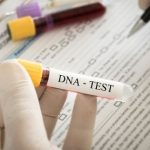As a DNA Relationship specialist, I have a lot of folks tell me that they assume that they are or are not related because of eye color, blood type or general appearance. Many people say things like “but the baby looks just like me” or ” I have a different eye color than everyone else in my family so I must be someone else’s child”. I am here to tell you that appearances are not always a good indication of who the parent is. I would like to offer some answers to these questions or assumptions.
It is not possible to conclusively confirm paternity by using blood typing. The only thing you can establish is that the parents of the child had specific blood groups such as A, B, AB, or O. This does not eliminate any one else within those groups. As you can see below there are many possible combinations based on blood type:

As you can see, blood type does not answer conclusively the question of paternity. And as well, appearance also cannot definitively answer that question. I have often heard, “she/he has brown eyes and both of her parents have blue eyes” so they are not sure who their parents are. Eye color cannot conclusively determine paternity. Eye color follows a polygenic inheritance pattern, and is probably controlled by 6 or more genes. Generally, these genes express themselves as one of 8 different eye colors. “Dark” is dominant at each of the 6 genes. The more dominant alleles present, the darker eye color appears. Therefore, eye color provides an even lower level of certainty than blood typing in determining paternity.
The same thing stands for hair color, let’s say red. It takes 2 carriers (Rr) to have a red-headed child.When a red hair carrier mates with a non-carrier, their children are not red headed, but some of their children will carry the red hair r allele. The frequency of the r alleles in the population in fact remains constant. We cannot easily tell if a person is a red hair carrier (Rr) without examining his/her extended family members’ hair colors or analyzing his/her MC1R gene. However, we can reasonably expect the population of red hair carriers is much greater than that of the redheads. Even though there is no redhead in your immediate family, the chance that you are a carrier (Rr) is still quite high. It is estimated that as many as one in four Caucasians in the US might be a red hair carrier. Therefore, if parents don’t actually have red hair, if they both carry the red hair gene their children can have red hair.
Therefore, as it turns out, there are so many variables when it comes to eye, hair , blood type or looks the most conclusive way to discover the truth is to perform a paternity or maternity test. I hope this provided your with valuable answers and addressed your questions or concerns.




